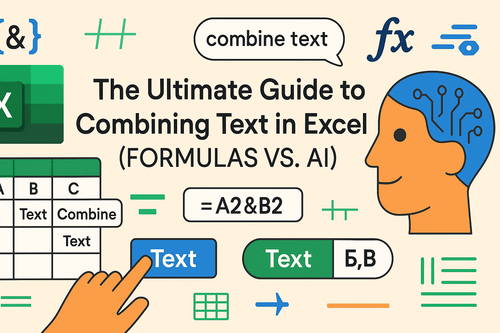Key Takeaways:
- Text extraction is essential for data cleaning and analysis in business scenarios like customer data processing and report generation, but traditional Excel functions require complex formula combinations
- Excelmatic's AI approach eliminates the need for nested formulas by letting you extract text using simple language commands
- Compared to traditional methods, Excelmatic handles complex text manipulation tasks like name parsing, email domain extraction, and data standardization with intuitive instructions
- For business professionals, adopting AI tools means faster data preparation and more time for analysis rather than technical formula work
Text manipulation is a fundamental skill in Excel that can dramatically enhance your data analysis capabilities. One essential technique is extracting specific portions of text, or "substrings," which allows you to clean messy data and analyze information more effectively.
Traditionally, this has meant mastering a suite of Excel functions, which often involves combining them into complex formulas. But what if there was a faster, more intuitive way? In this guide, we'll explore both the classic formula-based methods for text extraction and a modern, AI-powered approach using AI tools like Excelmatic. You'll see how to achieve the same results with a fraction of the effort.
Extracting Text by Position: The Classic vs. The AI Approach
We often want to extract a word or sequence of characters based on its position in a text string. Excel provides several built-in functions for this, but an AI assistant can often get the job done with a simple instruction.
The Traditional Method: Using Excel's Substring Functions
Excel's primary functions for extracting text by position are LEFT(), RIGHT(), and MID().
Using the LEFT() Function
You can use the LEFT() function to extract characters from the beginning of a text string. The syntax is:
=LEFT(text, [num_chars])
text: The cell containing the original text.num_chars: The number of characters to extract from the left (default is 1).
For example, to extract the first three characters from the product codes in cell A2:
=LEFT(A2,3)

Using the RIGHT() Function
The RIGHT() function extracts characters from the end of a text string. The syntax is:
=RIGHT(text, [num_chars])
To extract the last three characters from the product codes, you would use:
=RIGHT(A2, 3)
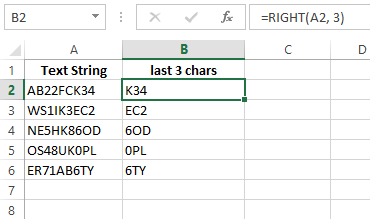
Using the MID() Function
The MID() function extracts characters from the middle of a text string. Its syntax is:
=MID(text, start_num, num_chars)
start_num: The starting position within the text string.num_chars: The number of characters to extract.
To extract three characters starting from the fourth position:
=MID(A2,4,3)

The AI Alternative: Using Excelmatic
While these functions are useful, they require you to know the exact function and its parameters. With an AI tool like Excelmatic, you simply describe what you want in plain English.

After uploading your file to Excelmatic, you could accomplish all the above tasks with simple prompts:
- For the
LEFTtask: "From the product codes in column A, create a new column with the first 3 characters." - For the
RIGHTtask: "Extract the last 3 characters from the product codes in column A." - For the
MIDtask: "Create a new column by extracting 3 characters from column A, starting from the 4th character."
The AI handles the underlying logic, giving you the result instantly without you needing to write a single formula.
Helper Functions for Complex Extractions
For more advanced tasks, you often need to combine the functions above with "helper" functions like FIND() and SUBSTITUTE().
The FIND() Function
FIND() locates a substring and returns its starting position. This is crucial when the text you want to extract doesn't have a fixed position.
FIND(find_text, within_text, [start_num])
For example, to find the position of "Camp" in "DataCamp":
=FIND("Camp", A2)

The SUBSTITUTE() Function
SUBSTITUTE() replaces specific text with new text.
SUBSTITUTE(text, old_text, new_text, [instance_num])
For example, to replace semicolons with commas:
=SUBSTITUTE(A2, ";" , ",")

Extracting Text by Delimiter
Delimiters are characters like commas or spaces that separate text. Newer Excel versions have TEXTBEFORE() and TEXTAFTER() to simplify this.
TEXTBEFORE() and TEXTAFTER()
=TEXTBEFORE(text, delimiter, ...)extracts text before a specific delimiter.=TEXTAFTER(text, delimiter, ...)extracts text after a specific delimiter.
For example, to get the text before the second comma in cell A2:
=TEXTBEFORE(A2, ",", 2)

And to get the text after the second comma:
=TEXTAFTER(A2,",",2)
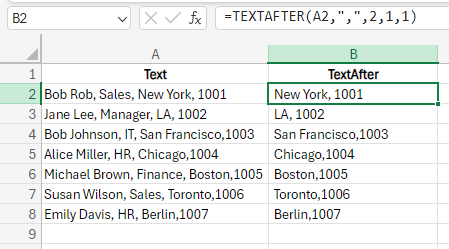
While powerful, these functions are only available in Microsoft 365 and Excel for the web.
Advanced Use Cases: Formulas vs. AI
This is where the difference between traditional methods and AI becomes stark. Complex tasks that require nested formulas can be solved with a single sentence.
Use Case 1: Handling Varying Lengths of First Names
Imagine you need to extract the first name from a list of full names. The length of each first name is different.
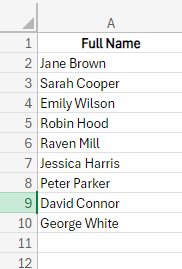
Traditional Method: Combining LEFT() and FIND()
You need to find the position of the space and extract everything before it.
=LEFT(A2,FIND(" ",A2)-1)
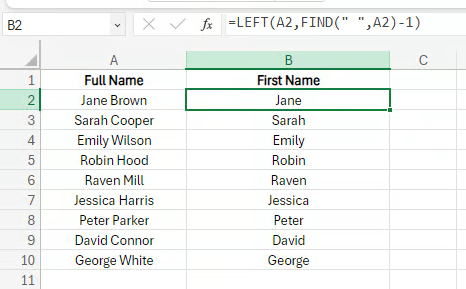
This works, but it's not intuitive. You have to remember to subtract 1 to avoid including the space.
AI Method (Excelmatic)
With Excelmatic, you just ask:
From the 'Full Name' column, extract the first name into a new column.
The AI understands the context and handles names of any length automatically.
Use Case 2: Extracting the Domain from an Email Address
You have a list of email addresses and need to pull out just the domain names.
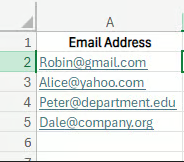
Traditional Method: Combining RIGHT(), LEN(), and FIND()
This requires a more complex formula to calculate the length of the domain name first.
=RIGHT(A2, LEN(A2) - FIND("@",A2))
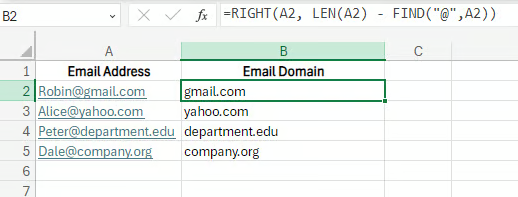
This combination of three functions can be difficult to construct and debug if it doesn't work correctly.
AI Method (Excelmatic)
The request is simple and direct:
From the email addresses in column A, extract the domain name.
Use Case 3: Cleaning Up Messy Data Entries
Your data contains phone numbers in multiple, inconsistent formats. You need to standardize them.
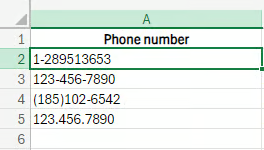
Traditional Method: Nested SUBSTITUTE() Functions
To remove hyphens, parentheses, and periods, you have to nest the SUBSTITUTE function multiple times.
=SUBSTITUTE(SUBSTITUTE(SUBSTITUTE(SUBSTITUTE(A2, "-", ""), "(", ""), ")", ""), ".", "")

This formula is long, hard to read, and prone to errors. If a new unwanted character appears (e.g., a space), you have to edit the formula again.
AI Method (Excelmatic)
A single instruction handles it all:
Clean the phone numbers in column A by removing all non-numeric characters.
Use Case 4: Reformatting Cleaned Data
After cleaning the phone numbers, you want to format them consistently as XXX-XXX-XXXX.
Traditional Method: TEXT, LEFT, MID, and RIGHT
This requires extracting each part of the number and then joining them back together with hyphens.
=TEXT(LEFT(B2, 3), "000") & "-" & TEXT(MID(B2, 4, 3), "000") & "-" & TEXT(RIGHT(B2, 4), "0000")

This is one of the most complex formulas in this guide, demonstrating the high learning curve for advanced text formatting.
AI Method (Excelmatic)
The AI approach is a two-step conversation. After cleaning the numbers, you simply ask:
Now, format the cleaned phone numbers in column B into the XXX-XXX-XXXX format.
Final Thoughts
You've now seen two powerful ways to manipulate text in Excel. Mastering functions like LEFT(), RIGHT(), and MID() is a valuable skill that gives you precise control over your data. It builds a strong foundation in how spreadsheets work.
However, the reality of modern data work is speed and efficiency. AI-powered tools like Excelmatic represent a paradigm shift, transforming complex, multi-step formula-writing into a simple conversation. Instead of memorizing syntax and debugging nested functions, you can focus on your goal and let the AI handle the execution.
Ready to simplify your text extraction tasks? Try Excelmatic today and experience how AI-powered data processing can accelerate your business workflows.
Whether you choose to become a formula guru, an AI power-user, or a bit of both, the ability to effectively extract and format text will remain a critical skill for anyone working with data.
Excel Substring FAQs
How do substring functions handle non-printable characters, and how do I clean them?
Traditionally, you use the CLEAN() function to remove non-printable characters before applying substring functions, for example: =LEFT(CLEAN(A1), 5). With an AI tool, you can simply ask it to "clean the data in column A and then extract the text."
Can substring functions split text into separate cells?
Yes. Traditionally, you can use the Text to Columns feature under the Data tab, or newer functions like TEXTSPLIT(). With an AI tool like Excelmatic, you can just say, "Split the 'Full Name' column into 'First Name' and 'Last Name' columns."
How do I dynamically extract text based on user input or cell references?
In classic Excel, you can use cell references within your substring functions to make them dynamic. For example, MID(A1, B1, C1) where B1 holds the start position and C1 holds the number of characters. An AI tool can also use context from your sheet, or you can specify the logic in your prompt, such as "Extract text from column A, starting at the position defined in cell B1 and for the length defined in C1."





